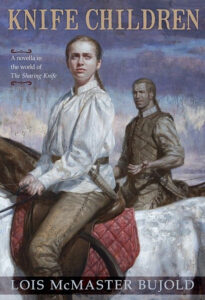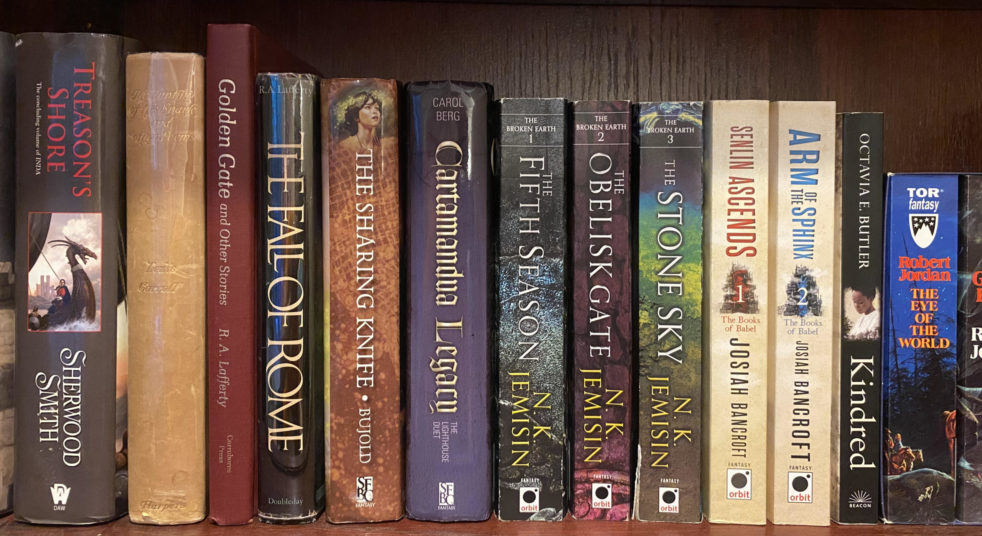
I’m a big fan of almost all of Lois McMaster Bujold’s work, and the combination of romance, fantasy adventure, and cross-cultural connection-building in The Sharing Knife made the series a highly enjoyable read. Despite all that, I’d never gotten around to the short sequel novel taking place a couple decades after the first four books. When Last in a Series popped up on this year’s Bingo board, I took that as a great opportunity to finally grab a copy of Knife Children.
[Note: Knife Children assumes familiarity with the world and makes sense to be read after the initial four, but while it alludes to some climactic events, it takes place so much later that it’s easy to review without spoilers.]
I expected Knife Children to follow literal children of the main couple in the initial four books, but instead, it follows an acolyte who in the intervening time has had a child of his own. The lead—one of the long-lived, magical Lakewalkers—had had a brief affair with a mundane Farmer girl. The mother had married soon after and never told her husband their first child wasn’t his, but the biological father would routinely check in from afar to make sure no budding magical ability needed to be dealt with. Unsurprisingly, the check-in that begins the book indicates some drastic changes in a short period, changes that saw the lead’s teenage daughter having fled, her family’s house destroyed, and one of her siblings dead. And so he takes it on himself to find her and figure out the best way to resolve whatever precipitated the troubles.
Knife Children is much lower on the romance than the previous books (though there is a small romantic subplot), but apart from that, it’s more of the same but with a different set of characters. If you’re here for a pinch of protecting against fantasy monsters and a whole lot of solving problems with words instead of with magic, you should have a good time with this one.
The overarching series theme of reaching past cultural differences to communicate openly and work together for mutual benefit is on full display here, but if there’s a secondary theme, it’s one of growing up and learning to manage increased responsibilities. The lead has gone through life with a reputation as a talented troublemaker with a good heart, proving useful in a fight and even in some level of mentorship but without ever taking on formal leadership roles. He’s watched out for his child from afar, but he’s certainly never had to act like a father. Meanwhile, his daughter is exiting literal childhood, fumbling her way through an adolescence complicated by abilities she can neither explain nor control. Suddenly, both have to step up in ways they’d never previously done.
The lead is old enough that the story doesn’t quite come off as a coming-of-age, and the timeline is a bit too short, with the scale of the main action being more like days than months. But both major characters have arcs that at least echo the coming-of-age story, not so much in the ways they learn to use their power, but in the ways they take on increased responsibility and more maturely interact with those around them.
Ultimately, Knife Children is a short and pleasant read that’s not seeking to shock the reader with boundary-pushing plots or themes; instead, it seeks to demonstrate an aspirational picture of cooperation across peoples, even in the midst of strife. For fans of the first four books, it’s an easy one to recommend. For others, take a look if you enjoy a little less fighting and a little more learning to handle problems like adults.
Recommended if you like: The Sharing Knife series, even when the romance slips into the background.
Can I use it for Bingo? It’s hard mode for Parent Protagonist, Stranger in a Strange Land, and Last in a Series. It’s also a Small Press title, and while there are some stakes, I could certainly see an argument for calling it Cozy (by Bingo standards, if not by marketing ones).
Overall rating: 16 of Tar Vol’s 20. Four stars on Goodreads.
